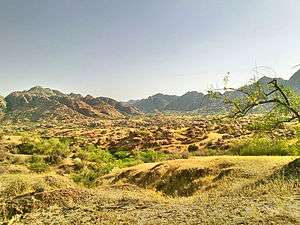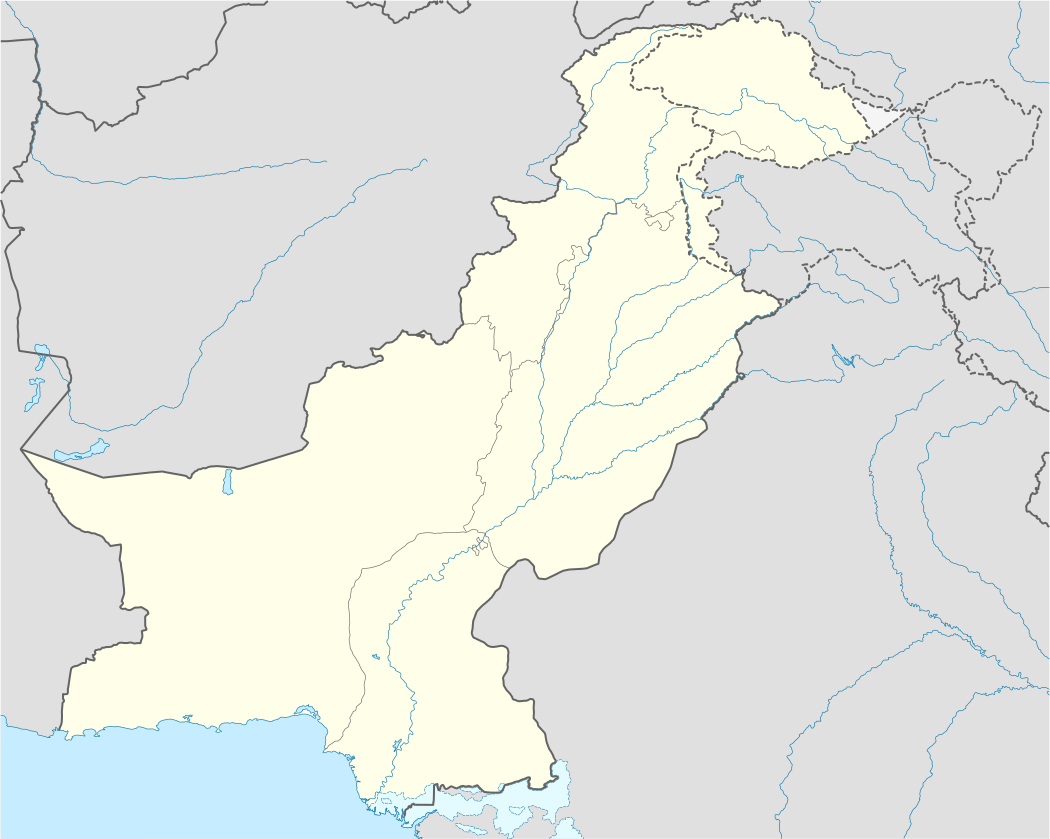Karoonjhar Mountains
Karoonjhar Mountains (Urdu: کارونجھر پہاڑیاں) are located in south-eastern edge of the Tharparkar district in Sindh, Pakistan. The range is approximately 19 kilometers long and reaches a height of 305 meters.[1]
| Karoonjhar Mountains | |
|---|---|
 | |
| Geography | |
| Range coordinates | 24°20′26″N 70°44′0″E |
Geography
Karoonjhar mountains are located in Nagarparkar near the district Tharparkar on the northern edge of the Rann of Kutch. They mostly consist of granite rock and are likely an extension of the Aravalli range of India. The Aravalli range belongs to Archaen period and thus one of the oldest rock systems. Karoonjhar area is geographically different from the surrounding desert and is very limited in expanse. The mountain range is around 19 kilometers long and 305 meters high. To the east of the main range lie smaller hills which are covered with sparse vegetation. From these hills originate two perennial springs,Achleshwar and Sardharo, and temporary streams, Bhetiani and Gordhro, which flow during the rainy season.[1]
Climate
Karoonjhar Dam is being constructed to supply water to people of Nagarparkar area. In monsoon season, the rain water pours down from the mountain and flows in more than twenty streams, Bhatiani, Maoo, Gordaro, Ranaser, Sukhpur, Ghatiari, Madanwah, Moondaro, Bhodeser, Lolrai, Drah, Puranwah to the Rann of Kutch. The climate of this mountain range is extreme due to rocky terrain, August and September are only cool months due to monsoon.
Economic Significance
Karoonjhar has economic significance for the local people of the area, it is rich in deposits and plant medicinal values. These plants include shatavari, okra and wild onion. This mountain is economically so significant that there is a local saying "Karoonjhar yields a hundred kilos of gold regularly.".
History
Karoonjhar has been mentioned in many verses of Sindhi and Gujarati poets. Myths and lores of Sadwant & Sharanga, Hothlal Pari (nature's fairy), Odho Jam (Sindhi lore) and Bherio Garori (wolf's ring) are regarded to this range. Hothlal Pari is considered to have had appeared 1st in the Karoonjhar mountains. In old times, Karoonjhar was also famously known as "Kinro". The mountain range has several places of historical importance, like Bhodeser Talao, Alakh Wao (hidden well), Anchlechure, Sardaro, Gao Mukhi, Punraj Gadr, Nani, Chandan gadr, Bhaun jo bheesro, Jharno and Bhaunro. In the past, many individuals were exiled to the Karoonjhar by monarchs of nearby states.[2]
References
- Karakilcik, Yusuf; Kalyar, Masood Nawaz (2014). "The Unexplored Jewel of Desert: Prospective Role of Thar Desert in Ecological and SocioEconomic Development of Pakistan" (PDF). Journal of Multidisciplinary Engineering Science and Technology. 1 (5).
- https://www.sindhidunya.com/karoonjhar-mountains-gigantic-mountains/

